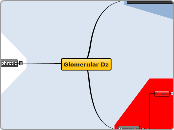Glomerular Dz
Mild clinical abnormalities
Primary
XLR, Hearing, Ocular, a5 of Type IV collagen
Alport's
LM
↑ed mesangial matrix
IF
EM
Multi-layer laminated
Thin Membrane Dz
LM
IF
EM
BM Thinning
IgA Nephropathy
LM
Normal or...
Mesangioprolif
IF
IgA Mesangial deposits
EM
IgA Mesangial deposits
Secondary
LN, mesangioprolif.
LM
Proliferation of mesangial cells, matrix
IF
IgG, Complement, IgA in Mesangium
EM
Dense deposit in mesangium
Mild Diabetes
Benign HTN
Nephritic
Primary
"Lumpy-bumpy", GAS
PIGN
LM
Diffuse proliferative
PMNs
IF
Coarsely granular = "lumpy bumpy"
EM
2 or 3 Large Humps
Hypocomplementemia
Immune Complex
MPGN-1
LM
Duplicated BM
IF
IgG, C3
EM
Split BM
Subendothelial deposits
Alt. path of Complement
MPGN-2 (DDD)
LM
Duplicated BM
IF
C3 Nephritic Factor
EM
Entire BM is darkened
IgA Nephropathy
LM
Normal OR
Mesangioprolif
IF
IgA Mesangial deposits
EM
IgA Mesangial deposits
Secondary
Malar rash, Anti-Sm Ab
All Glomeruli involved
LN, diffuse prolif.
LM
Wire Loop
Hyaline thrombi
IF
"Full House"
EM
Subendothelial, Mesangial Deposits
Few glomeruli, segment of glom. tuft
LN, focal prolif.
LM
IF
"Full House"
EM
Child: GI, Joint, Skin
Henoch-Schonlein purpura
Vasculitis
C-ANCA
Wegener's Granulomatosis
Lung Granuloma
P-ANCA
Hypersensitivity angiitis (microPAN)
Crescents
Fibrinoid necrosis
Focal necrotizing GN
HBsAg
Classic PAN
Renal infarct
anti-BM
GN, no lung
GN+Lung, Type II Hypersens.
Male, Hemoptysis, Dyspnea, Discolored urine
Goodpasture's
Nephrotic
Primary
1-3 yo, T-cell cytokines affect BM charge, steroids
Min. Change Dz
LM
IF
EM
Effacement of epithelial foot processes
Black, ↓GFR, HTN, Poor response to steroids
Idiopathic FSGS
LM
Segmental, Focal lesions
Obliterated capillary lumen
Variant FSGS
Collapse of glomerular capillary loops
IF
EM
Hyaline
Foam cells
Focal damage of VECs
Effacement of epithelial foot processes
Epithelial cell detachment from BM
White adult, Poor response to steroids
Membranous GN
LM
Diffuse, thickened BM
IF
Finely Granular
IgG, C3
EM
Numerous, small subepithelial deposits
Renal transplant, Neg. for Immune complex Dz
Transplant GN
LM
IF
EM
Subendothelial electron-lucent widening
Secondary
(Pos) Congo Red, Crystal Violet, Thioflavin T
Amyloidosis
Gross
Dark brown w/ Iodine
Microscopic
Homogenous, pink
(Neg) Congo Red
Fibrillary GN
Fibrils larger than amyloid
LN,membranous
Membranous (Other)
FSGS
HIV
Collapsing features
Rapid progression to ESRD w/in months
Heroin
Obesity
Reflux Neph: Unilateral renal agenesis
